
Colorado Secretary of State Wayne Williams (left), Oregon Secretary of State Jeanne Atkins, California Secretary of State Alex Padilla, and Doug Chapin, director of the Program for Excellence in Election Administration at the University of Minnesota. (Photo Credit: John Guenther/CA Fwd)
The importance of expanding voter participation and modernizing California elections was on full display in Los Angeles at the 2016 Future of California Elections Conference.
A full house of election officials, civil rights organizations and election reform advocates gathered at the California Endowment on Thursday.
The headliner was a panel that featured three Secretaries of State who are the forefront of innovative reforms in voter registration and election administration.
California’s Alex Padilla was joined by Jeanne Atkins of Oregon and Wayne Williams of Colorado in a brisk and entertaining session that covered some of the ways they are working to increase voter participation.
For Padilla, the goal has been pretty simple.
“Get more people registered and get more people voting,” he said.
California legislators are considering SB 450—a bill that Padilla endorses–which would authorize a county to conduct any election as an all-mailed ballot election if certain conditions are satisfied, including creating expanded early voting options, ballot drop-off locations and polling vote centers.
What people envision in California is already happening in Colorado and a couple of interesting things have happened. Voter turnout is increasing while only 5 percent of those who voted chose to do so in person.
“We’re pushing ballots to voters through the mail and they are voting,” said Wayne Williams of Colorado. “The key is to make it easy for them to return the ballots to voting centers in their county.”
Oregon, which like Colorado normally has a high voter turnout, passed a “motor voter bill last year and it appears the new law will bear fruit.
Automatic voter registration is available if you are eligible to register to vote and you apply for your original, renewal, or replacement license, permit, or ID card at the DMV.
Once you engage the Oregon Motor Voter process by visiting the DMV, you will receive a card and a pre-paid postage return envelope from the Oregon elections office. The card provides three options:
- Do nothing. You will be registered to vote as a non-affiliated voter, meaning not choosing to affiliate with a political party.
- Choose a political party by returning the card. Joining a political party will allow you to vote in its primary elections.
- Decide not to vote.
Oregon runs its elections through all-mail balloting. Among Oregonians who voted, 40 percent return their ballots through the mail, while 60 percent will drop them off a voting center.
“More people will vote,” predicted Oregon’s Atkins, who was appointed Secretary of State when her predecessor was elected Governor.
California’s new version of its “motor voter” law was just signed by Governor Brown last year. Now, every eligible California citizen who goes to a DMV office to get a driver’s license or renew one will be instantly registered to vote, unless he or she chooses to opt out.
There are 7 million Californians who are eligible to vote but not yet registered. Padilla believes this law and the ability to register online can put a dent in that number.
Padilla pointed out that of the people who are now registering to vote are increasingly non-partisan.
“The percentage of people registering as Democrats or Republicans is going down,” he said. “While that bothers some political types, it’s not my concern as Secretary of State.”
Another highlight of the day was when Padilla presented the members of the new Language Accessibility Advisory Committee, which will address such voting access issues like translating voting materials and doing outreach into communities where English is a second language.
Other FoCE panels that drew interest included discussions of boosting youth turnout, designing election information material, and how California pays for elections. Election administrators are facing rising costs and significant barriers, include replacing aging voting systems.
“Some California counties have old voting systems and then others have old, old voting systems,” Padilla said drawing a laugh from the audience.
California Forward, which has been surveying election officials in the state and in other states about the issue of how elections are adequately funded, shared some of its preliminary findings on ways to solve this vexing problem.
“We found that counties believe funding is inadequate for new laws and regulations, complying with mandates, purchasing voting systems and conducting special elections,” said Caitlin Maple, CA Fwd research analyst who made a presentation at the elections funding panel.
After compiling the feedback from surveys and meetings with registrars, CA Fwd posed some possible ways to improve election financing and administration:
- Updating certification and procurement processes to accommodate new technology
- Anticipating and incorporating technology options
- Develop a funding mechanism with the right incentives
- Determining the “fair share” of election costs, such as State funding for special elections, statewide offices and ballot measures
- Creating incentives for efficiency, cooperation and continuous improvement
FoCE, which is supported by the James Irvine Foundation, is now five years old and has “played a central role in focusing strategies to implement needed reforms,” said Vince Hall, Executive Director.
The conference wraps up on Friday.

